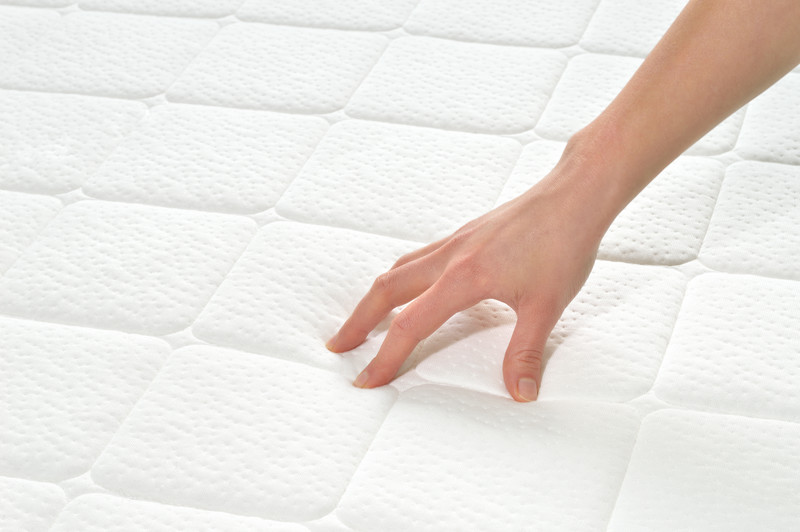Every purchase made online is encrypted with a high level of security you’ve come to expect. Your private information is never shared nor sold, so you can buy with confidence. You can also visit our store if you are in the St. Louis area.

Like all home furnishings, the condition of your mattress will deteriorate over time. The lifespan of a mattress is affected by various factors, such as:
- materials
- quality
- intensity of use
- care
Table of Contents
Mattress Materials
A mattress made with poor materials will deteriorate more quickly than those made with high-quality materials.
For instance, the quality of materials used to create a mattress’s comfort layer is an easy way to determine its overall lifespan. Mattresses made with low-quality foam for the comfort layer can see noticeable wear within one year of purchase. Elements such as a fine latex core can last for more than twenty years. Meanwhile, innerspring cores offer a midway point of a ten-year lifespan.
There are two ways to extend the life of the comfort layer, and therefore the entire mattress. One is to flip a double-sided mattress, essentially allowing the comfort layer to be accessed from both sides. Another option is to utilize a topper, which can be replaced as it deteriorates without affecting the mattress itself.
Quality
A mattress is the sum of its parts, so the quality of a mattress is determined by the pieces used to create it.
Coil Spring Mattress
The core of a mattress is usually made up of steel coil springs. The gauge or thickness will factor into the quality of the mattress in addition to determining firmness and support. The coils are measured in quarter increments; the smaller the number, the thicker the spring. High-quality springs measure at 14-gauge. Coils between 14 and 15.5-gauge offer more give while 12.5-gauge springs are the firmest.
Mattress coils are available in four different types:
- Bonnell coils: First developed in the 19th century for use in buggy seats, Bonnell springs are knotted with a round top and hourglass shape made of steel. Bonnell units are coils laced together with cross wire spirals.
- Offset coils: Hourglass coils with flattened top and bottom sections. The flattened sections are held together with helical wires to form and innerspring unit, forming a mattress that is designed to conform to the shape of your body.
- Continuous coils: Instead of individual coils, this configuration consists of rows of coils formed from a single piece of wire that works similarly to offset coils
- Marshall coils (also known as wrapped coils, encased coils, or pocket springs): These thin-gauge, barrel-shaped coils are separately encased in fabric pockets so that they work independently of one another, allowing for individual movement and support.
Foam Mattress
There are a variety of all-foam and partial-foam mattresses on the market, including materials such as flexible polyurethane, visco-elastic, memory foam, and latex rubber foams as well as polyurethane and visco-elastic foams combined with plant-based content.
- Latex foam: Latex foam mattresses are typically a blend of synthetic and natural latex, although some all-natural latex mattresses are available. Synthetic foam is produced using either the Talalay or Dunlop process, the first which produces a softer feel than the latter.
- Memory foam: These mattresses use visco-elastic foam over a polyurethane base. The base is a firmer substance while the foam covering conforms to the body.
- High-density foam: High-density foam mattresses use a compact foam made from polyurethane with large open cells that are packed tightly together. These mattresses offer an innerspring system to help prevent sagging that often occurs with time.
Bladder Mattresses
Some mattresses are made without spring or foam, but rather are bladders that can be filled, particularly with air or water. Air mattresses have chambers that are filled with air to supply support, typically through the use of baffles.
Waterbeds are filled with water rather than air and utilize various types and amounts of fibers to produce the level of firmness desired.
Intensity of Use
How often one uses a mattress and how long one keeps it are also determining factors in its lifespan. Mattresses are expected to last approximately ten years, and most Americans replace theirs after a decade of use. People may replace their mattress because of a variety of reasons, including deterioration, cleanliness, and issues with pain.
Care
The lifespan of a mattress is also affected by the care put into it. Be sure to regularly rotate your mattress and flip it as well to help it wear more evenly. Newer beds typically do not need flipped, but instead should be rotated every two weeks for the first two months of ownership, followed by every three months after that. Box springs should be rotated every six months.
Do not eat or drink while in bed to help protect it from stains or damage. You can also cover your bed with waterproof, washable mattress cover. Some mattress covers even protect against allergens and bedbugs.
Many people don’t realize that one effective method of cleaning a mattress is with a vacuum cleaner. It can prevent dust and dirt from becoming ground in. If you spill something, you can clean it with a little bit of warm, soapy water on a clean washcloth. Be sure not to overdo the water, because too much moisture can cause mold.
Lifespan of a Mattress
A quality mattress can last between five and ten years if properly kept and cared for. Be sure to use it properly, regularly wash your sheets, and maintain your mattress as suggested by the manufacturer. Proper care may extend the life of your mattress and keep it comfortable for its entire lifespan.
